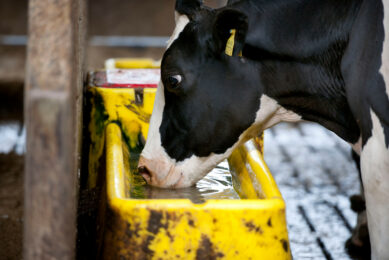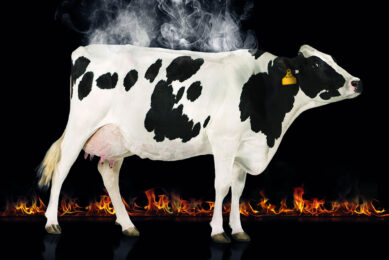Feeding cows to nourish the dam and the calf
![It is important to nourish and proper feed the pregnant cow to make sure the fetus and newborn calf don't have to deal with deficient amounts of macro and micronutrients. [Photo: Robin Britstra]](https://www.allaboutfeed.net/app/uploads/2020/12/001_52_rb-image-2677678.jpeg)
Nourishing the pregnant cow benefits the offspring’s health and production later in life. Therefore, the energy ?balance and nutrition of the pregnant cow must be given proper attention.
Nutrient supply and hormonal signals at specific windows during development (both pre- and early postnatal) may exert permanent changes in the metabolism, as well as changes in performance, body composition, and metabolic function of the offspring of livestock. This is due to processes generically referred to as foetal programming and metabolic imprinting. Thus, it is likely that the cow of today, with high milk yield but also reproductive and metabolic challenges, is not only a consequence of genetic selection, but also the result of the way her dam was fed and the way she was fed early after birth. This article reviews the recommended feeding practices for pregnant cows and the potential connections between nutrition of the dam and metabolic function, milk production, reproduction, and susceptibility to disease of the offspring, as well as future milking performance of the dam.
Nourishing the pregnant cow
Since the early 1990’s (and especially after the release of the NRC model in 2001, which recommends energy densities around 1.60 Mcal of NEl/kg during this period) late pregnant cows have been fed high-energy rations in the immediate pre-calving period to 1) compensate for the assumed decrease feed intake as calving approaches, 2) minimise body fat mobilisation, ketosis, and fatty liver after calving, 3) adapt the rumen microflora towards a high nutrient dense ration (that will be fed post-calving), and 4) foster the growth of rumen papillae to minimise the risk of rumen acidosis during lactation through an improved absorption (and removal) of volatile fatty acids from the rumen. The first two objectives (compensate reduction of feed intake and minimise body fat mobilisation) do not seem to be attained by feeding high-energy diets before calving. The third objective (adapting the rumen microflora to a high-starch diet) is also debatable. In ruminant nutrition it has typically been assumed that at least three weeks are needed for the rumen microflora to adapt to a dietary change. However, the vast majority of organisms in the rumen are bacteria and they can double their population in as quickly as 20 minutes. Thus, three weeks seems like an extremely long time to consolidate a change in terms of bacteria lifespan. In fact, researchers have recently evaluated changes in the rumen microbial population when shifting steers from a prairie-based diet to a high-grain ration. Within a week of each step-up (animals were gradually moved to a high-grain diet), the authors already reported drastic changes in the rumen microbial population. Lastly, the fourth objective (fostering growth of rumen papillae) could also be argued. The NRC (2001) made this recommendation based on a study from 1985 that compared the characteristics of rumen papillae between cows fed a straw-based gestation ration to a high concentrate lactation ration. However, studies substituting barley for forage in the diets of late-gestation dairy cows, in an attempt to increase rumen acid load and alter rumen volatile fatty acid concentrations, had no effect on rumen papillae characteristics or subsequent lactation performance. Furthermore, a more recent study that compared a high fibre diet vs the same diet plus additional 800 g/d of barley pre-calving reported that total mass of rumen papillae excised from the floor of the cranial sac was not affected by transition diets, but the number tended to be greater when barley was fed, and this was associated with a marked reduction in average width, which resulted in a reduced average surface area. Thus, it would seem that there would be no need to ‘adapt’ rumen papillae before calving by providing high-starch diets.
Nourishing the calf
Most of gestation, especially the first two-thirds, in the lactating cow coincides with lactation, and embryonic development must compete for nutrients against the demands of maternal milk production. Nutrition is among the most influential intrauterine factors dictating placental and fetal growth. In dairy cattle, there is little information about the potential effects of the maternal metabolic status on subsequent metabolic function of the offspring, and nutrient requirements associated with early pregnancy are ignored and unknown (NRC, 2001). However, embryonic metabolic activity is high and it is a critical period for organogenesis and tissue hyperplasia and foetal development is most vulnerable to maternal nutrition around the peri-implantation period and during rapid placental development. Several studies have reported clear effects of under-nutrition during pregnancy on birth weight. In addition to obvious effects on birth weight, maternal (and foetal) nutrition can have long-term metabolic consequences that might be less obvious to identify. For example, a study done in 2000 illustrated the importance of foetal metabolic environment on future metabolic function of the offspring when, in a study involving Pima Indians (a population with a great incidence of type II diabetes), they reported that siblings born to mothers that had diabetes had twice as much risk of having type II diabetes than those that were born before the mother had type II diabetes. Thus, the foetal environment clearly programmed the metabolism of the offspring and its consequences were seen later in life, not at birth. Whether this phenomenon occurs in dairy cattle is not well known. In 2007, it was reported no significant effects of maternal milk production during pregnancy on subsequent offspring milking performance in the first lactation, but other researchers found a negative relationship between milk production of the dam and milking performance of the offspring in the first and third, but not second, lactations and concluded that the majority of the maternal effects in progeny performance were due to factors other than maternal milk production. The lack of an association between milk production and long-term effects on the offspring is most likely due to the fact that different milk production levels can occur with distinct metabolic environments in the dam (i.e., negative, neutral, or even positive nutrient balances), and thus, it seems clear that it is the latter, not milk yield per se, that may exert modifications in the metabolic function of the offspring.
Protein deficiency has an effect
It was also shown that protein deficiency (i.e., 65% of recommendations) may compromise the reproductive performance of the offspring. For instance, in primiparous beef cows during the last 100 days of pregnancy delayed age at puberty of the progeny, whereas heifers born to dams supplemented with protein during the last third of pregnancy had increased pregnancy rates compared with heifers born to non-supplemented dams. Furthermore, protein deficiencies at the end of the gestation seem to alter the hormonal content of the colostrum and this, in turn, may compromise intestinal maturation and the immune passive transfer of the calf. Linear decreases in protein intake during the last 100 d of gestation resulted in linearly impaired serum IgG concentrations in the calf, despite the fact that IgG concentration in the colostrum and amount of colostrum consumed by calves was not affected. In 2010, researchers illustrated that a moderate (i.e., ~80% of recommendations) nutrient restriction during early to mid-pregnancy of beef cattle altered the jejunal proliferation and total intestinal vascularity of the foetus, which could alter the capacity for IgG absorption.
Effect of heat stress on newborn calvesNot only the nutritional environment may program or alter the metabolism of the offspring. For instance, Tao and Dhal (2013) reported that heat stress in late gestation decreases birth weight of newborn farm animals, which reflects compromised foetal development in utero. Interestingly, foetal growth retardation under heat stress is independent of the nutritional status of the dam. Furthermore, it was described that heat stress of the dam during the dry period compromises immune function of offspring from birth through weaning. Across many species under thermoneutral conditions, the foetus has a consistently higher body temperature relative to its dam, which is mainly due to poor heat exchange with the dam and about a 2-fold greater metabolic rate of the foetus relative to that of the dam. Interestingly, calves born to heat-stressed dams have greater insulin concentrations (which may suggest a state of insulin resistance) relative to calves born to cooled dams when consuming the same amounts of colostrum the first four days after birth. |
Sufficient amounts of micronutrients
Although macro nutrient requirements (energy, protein, etc.) for embryonic growth are low in early pregnancy, it is likely that the embryo is sensitive to deficiencies of micronutrients such as specific amino acids, vitamins, etc. as well circulating concentrations of hormones and growth factors. For example, arginine, leucine, and glucose are essential for the correct development of the histotroph. Also, vitamin A is important in regulating early lung development and alveolar formation, and thus maternal vitamin A status is an important determinant of embryonic alveolar formation and respiratory health. It was recently reported that, in humans, vitamin A supplementation of deficient pregnant mothers greatly improved the respiratory health of the offspring. Methionine has been identified as a limiting amino acid in both lactating and dry cows. Methionine has been reported to be transported into bovine embryonic cells and to participate in the regulation of translation and DNA methylation. Thus, perturbations in the methionine-homocysteine and folate cycles, associated with inadequate methionine supply during development stages, may lead to hypomethylation of DNA and dysregulation of gene expression and metabolism of the offspring. In 2007, evident changes were reported in the methylation status of lambs born to mothers with a restricted supply of methyl donors (i.e., vitamin B12, folate, and methionine) compared with those born to ewes under physiological ranges. Vitamin B12 is a water-soluble vitamin produced by rumen microbes for their use and use by the host animal. In early lactation, dairy cattle fed supplementary folic acid and rumen-protected methionine were observed to have lower-than-optimal levels of vitamin B12, confirmed by reduced serum methylmalonic acid concentrations and increased milk production of primiparous cows given weekly intramuscular vitamin B12 injections; thus, it could be hypothesised that the foetus of cows that become pregnant in early lactation may experience some shortages of vitamin B12, and thus, potentially, a shortage of methyl donors and some dysregulation in gene expression. In fact, in humans, a clear correlation between vitamin B12 status and the degree of methylation of the offspring has been recently documented. Furthermore, reduced methylation of several genes in cord blood DNA has been associated with increased folic acid intake during pregnancy and genome-wide DNA methylation in cord blood DNA correlated inversely with maternal plasma homocysteine concentration.
Conclusion
Most of gestation, especially the first two-thirds, in the lactating cow coincides with lactation, and embryonic development must compete for nutrients against the demands of maternal milk production. It is therefore important to nourish the pregnant cow and to make sure enough macro and micronutrients are available. It was also shown that protein deficiency (i.e., 65% of recommendations) may compromise the reproductive performance of the offspring. Adequate nutrient supply to the foetus in the form of micronutrients (such as vitamins and amino acids) is key. Vitamin A for example is important in regulating early lung development and alveolar formation. It can be expected that in the near future, pregnant cows will be supplemented with specific amounts of nutrients to ensure optimal foetal development.
References are available on request.











